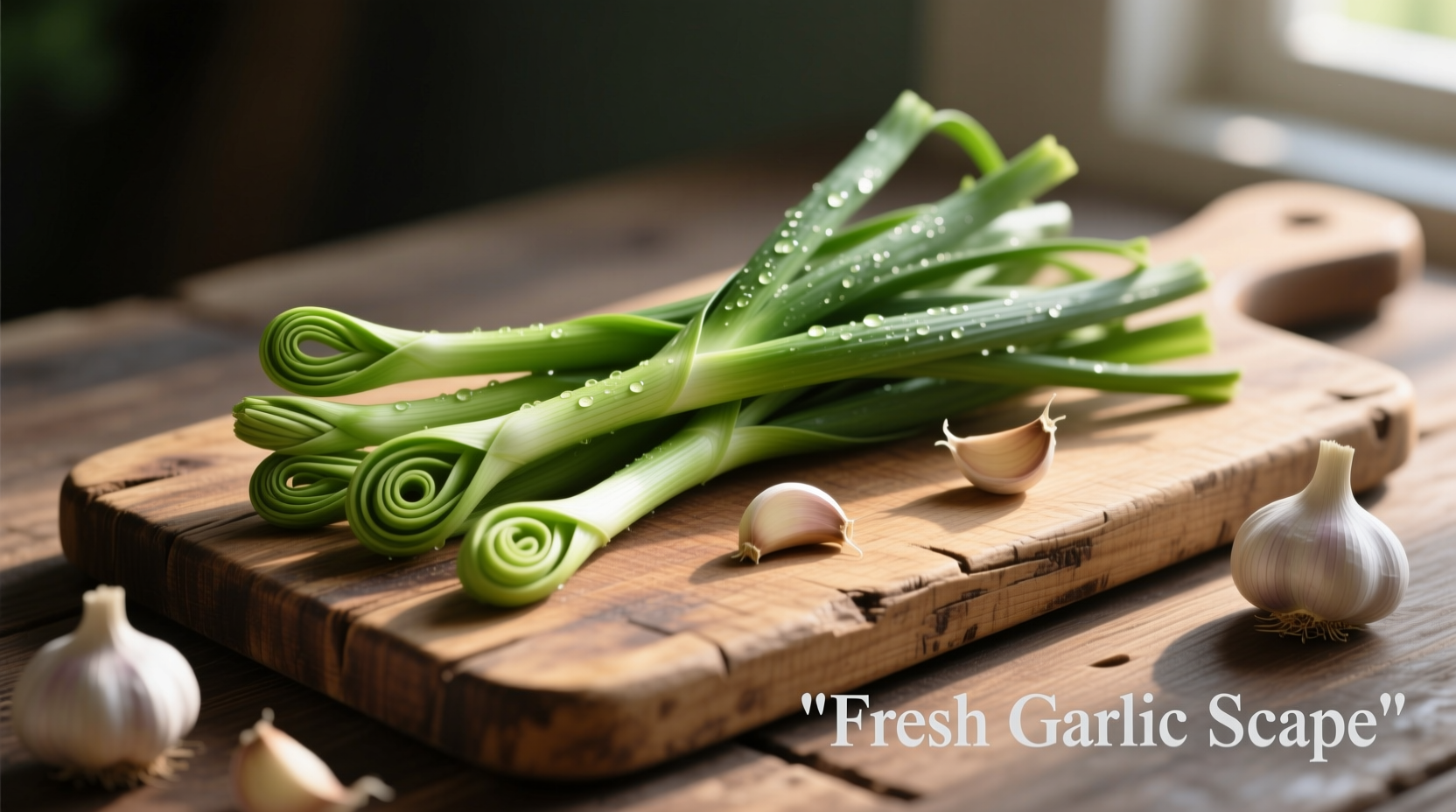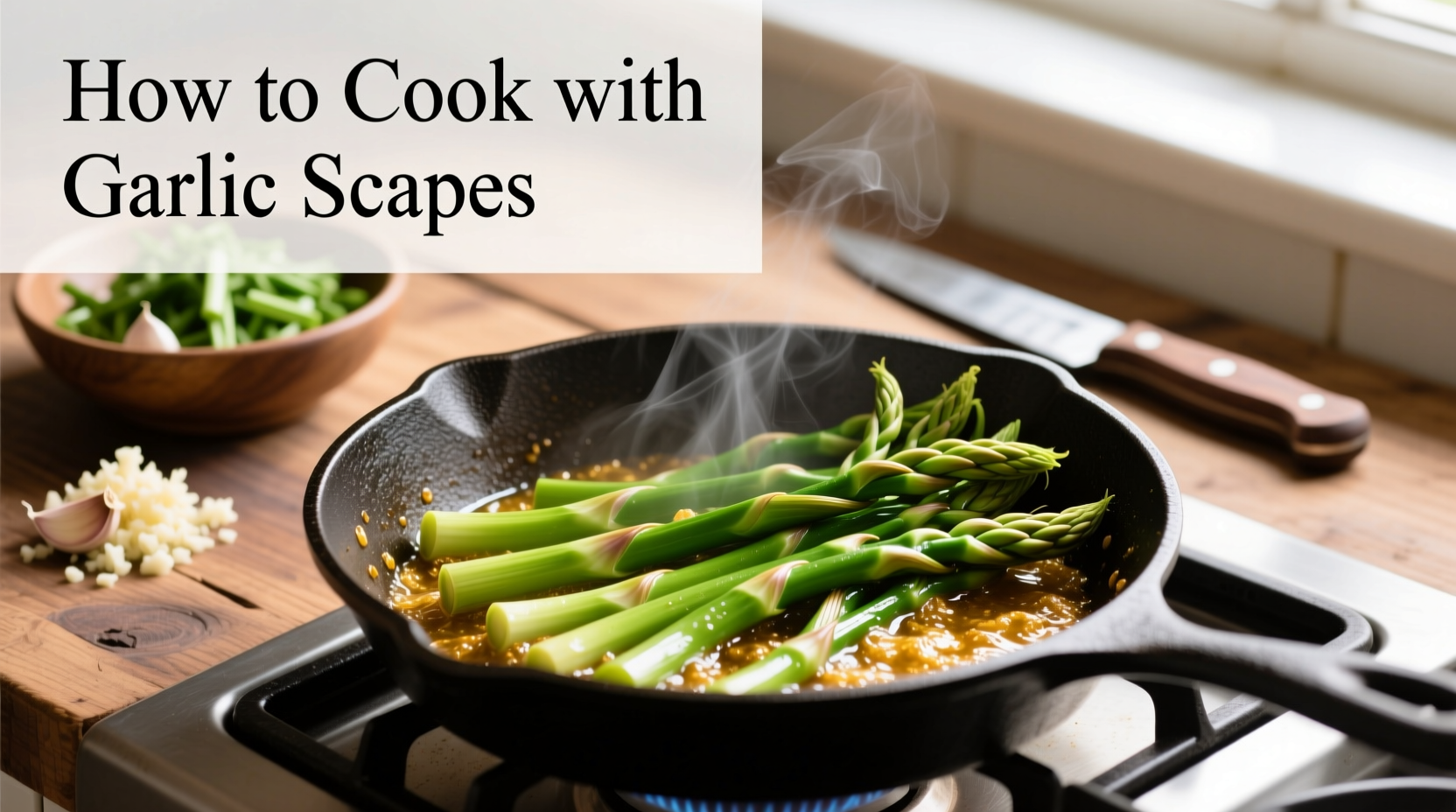Garlic scapes are the curly green flower stalks of hardneck garlic plants, harvested in late spring to early summer. They offer a milder, fresher garlic flavor than cloves and can be used in pesto, stir-fries, soups, and as a grilled vegetable. This guide shows you exactly how to prepare and cook with them, including step-by-step techniques and five simple recipes that maximize their unique flavor.
Have you ever wondered what to do with those curly green stalks that come with your farmers' market garlic? You're not alone. Garlic scapes, the often-overlooked flower stalks of hardneck garlic plants, represent one of summer's most delicious seasonal treasures. Unlike mature garlic cloves, these tender shoots deliver a subtle garlic flavor with grassy, herbal notes that won't overpower your dishes. As a chef who's worked with garlic scapes for over a decade across professional kitchens and home cooking demonstrations, I've discovered they're incredibly versatile when handled properly.
According to Cornell University's agricultural extension, garlic scapes appear in late spring when hardneck garlic varieties send up these distinctive curly stalks before flowering. Harvesting them actually improves bulb development, making them a win-win for growers and cooks alike. The season is brief—typically just 3-4 weeks in late May through June—so knowing how to use them properly ensures you won't waste this fleeting ingredient.
Understanding Garlic Scapes: More Than Just Young Garlic
Before diving into cooking techniques, let's clarify what makes garlic scapes special. These aren't immature garlic cloves but rather the flowering stalk that grows straight up from the garlic bulb before curling into that distinctive spiral shape. The entire scape is edible, though the tough, fibrous blossom end requires special handling.
| Characteristic | Garlic Scapes | Regular Garlic Cloves |
|---|---|---|
| Flavor Profile | Mild, fresh, grassy with subtle garlic notes | Strong, pungent, intense garlic flavor |
| Texture | Tender-crisp when raw, softens when cooked | Firm when raw, softens significantly when cooked |
| Seasonality | Late spring to early summer (3-4 week window) | Available year-round (stored bulbs) |
| Nutritional Value (per 100g) | Higher in vitamin C and certain antioxidants | Higher in allicin compounds |
This comparison, based on USDA nutritional data and culinary observations, shows why scapes deserve their own preparation methods rather than being treated as mere garlic substitutes. Their delicate flavor profile responds best to gentle cooking techniques that preserve their unique characteristics.
Step-by-Step Preparation: Getting Garlic Scapes Ready to Cook
Proper preparation makes all the difference in garlic scape dishes. Follow these professional kitchen techniques:
Cleaning and Trimming
- Rinse scapes under cool running water, gently rubbing to remove any soil
- Identify the tough, fibrous blossom end (the very tip that's beginning to form a flower head)
- Cut off the bottom 1-2 inches (the part closest to the bulb) which tends to be woody
- Remove the very tip blossom end which is too tough to eat
- For most recipes, cut the remaining stalk into 2-3 inch pieces
University of Minnesota Extension recommends storing unwashed scapes in a plastic bag with a paper towel in the refrigerator for up to two weeks. For longer storage, chop and freeze them in ice cube trays with olive oil—a technique many professional chefs use to preserve seasonal flavors.
Top Cooking Methods for Perfect Garlic Scapes
Garlic scapes respond differently to heat than regular garlic. Their higher water content and delicate flavor require specific approaches:
Sautéing: The Quick Flavor Builder
This is my go-to method for incorporating garlic scapes into dishes. Unlike regular garlic which burns easily, scapes can handle slightly higher heat for longer periods.
- Heat 1-2 tablespoons of olive oil in a skillet over medium heat
- Add chopped scapes and cook for 3-5 minutes until bright green and tender-crisp
- Season with salt to enhance their natural flavor
- Add to omelets, pasta dishes, or grain bowls
Blending: Unlocking Maximum Flavor
Raw garlic scapes blend beautifully into sauces and dips. Their milder flavor means you can use more without overwhelming the dish:
- Use in place of basil for a unique pesto (recipe below)
- Add to salad dressings for subtle garlic notes
- Blend into mayonnaise for a flavorful sandwich spread
- Incorporate into vegetable dips for added complexity
Grilling: Bringing Out Natural Sweetness
When tossed with olive oil and grilled over medium heat for 3-4 minutes per side, garlic scapes develop a wonderful caramelized exterior while maintaining a tender interior. This method works particularly well for whole scapes and makes an impressive side dish.

Five Simple Garlic Scapes Recipes You'll Make All Season
1. Simple Garlic Scape Pesto (The Perfect Starter Recipe)
This beginner-friendly recipe showcases garlic scapes' versatility. Unlike traditional basil pesto, this version has a more complex flavor profile with subtle garlic notes that won't dominate.
- 2 cups chopped garlic scapes (about 8-10 stalks)
- 1/2 cup toasted pine nuts or walnuts
- 1/2 cup grated Parmesan cheese
- 1/2 cup extra-virgin olive oil
- 1 small clove regular garlic (optional for stronger flavor)
- Salt to taste
Combine scapes, nuts, and cheese in a food processor. Pulse until coarsely chopped. With motor running, slowly add olive oil until smooth. Season with salt. Toss with pasta, use as a sandwich spread, or dollop on roasted vegetables.
2. Garlic Scape Compound Butter
This freezer-friendly preparation extends the short garlic scape season. Chop 1/2 cup scapes finely and mix with 1 cup softened butter, lemon zest, and salt. Roll into a log using parchment paper, then freeze. Slice off rounds to melt over grilled meats or vegetables.
3. Stir-Fried Garlic Scapes with Spring Vegetables
Combine sliced scapes with asparagus, snap peas, and baby carrots. Stir-fry in sesame oil with ginger for 4-5 minutes until tender-crisp. Finish with a splash of soy sauce and rice vinegar. This dish highlights how garlic scapes complement other spring produce without overwhelming their delicate flavors.
Avoiding Common Garlic Scape Mistakes
Even experienced cooks make these errors when working with garlic scapes for the first time:
- Overcooking: Garlic scapes turn mushy quickly. Remove from heat when they're still slightly crisp.
- Wasting the tough parts: Don't discard the thicker lower sections—slice them thinner or cook them slightly longer than the tender upper portions.
- Treating them like regular garlic: Their milder flavor means you'll need to use more volume to achieve similar impact.
- Not adjusting seasoning: Because scapes are milder, you may need to add salt later in the cooking process than you would with regular garlic.
Seasonal Pairings and Substitutions
Garlic scapes shine when paired with other spring and early summer produce. They complement asparagus, peas, new potatoes, and fresh greens beautifully. When substituting in recipes, use about twice the volume of scapes compared to regular garlic cloves to achieve similar flavor intensity.
Remember that garlic scapes have a limited season—typically available from late May through June in most North American growing regions. If you miss the fresh season, frozen scapes work well in cooked applications though they lose some texture. Never substitute dried garlic powder, which lacks the fresh, grassy notes that make scapes special.
Can I eat the entire garlic scape?
While most of the garlic scape is edible, the very tip where the flower would form is typically too tough and fibrous to eat. The bottom inch near the bulb can also be woody. For best results, trim both ends and use the middle portion which has the ideal tender-crisp texture.
How long do garlic scapes last in the refrigerator?
Properly stored in a plastic bag with a paper towel to absorb moisture, garlic scapes will keep for 1-2 weeks in the refrigerator. For longer storage, chop them and freeze in ice cube trays with olive oil, which preserves their flavor for up to 6 months.
What's the best way to freeze garlic scapes?
Chop scapes into 1-inch pieces, spread on a baking sheet, and freeze until solid. Transfer to freezer bags, removing as much air as possible. Alternatively, blend with olive oil and freeze in ice cube trays. This preserves flavor and makes them easy to incorporate into future dishes.
Can I substitute garlic scapes for regular garlic in recipes?
Yes, but you'll need to adjust quantities. Garlic scapes have a milder flavor, so use about twice the volume of scapes compared to regular garlic cloves. They work best in dishes where you want a subtle garlic flavor rather than a dominant one.
Why are my garlic scapes tough after cooking?
Overcooking is the most common reason. Garlic scapes should be cooked just until tender-crisp—typically 3-5 minutes when sautéing. The thicker lower portions may need slightly longer than the tender upper sections, so add them to the pan first. If using the entire scape, slice the thicker parts thinner than the tender tips.











 浙公网安备
33010002000092号
浙公网安备
33010002000092号 浙B2-20120091-4
浙B2-20120091-4